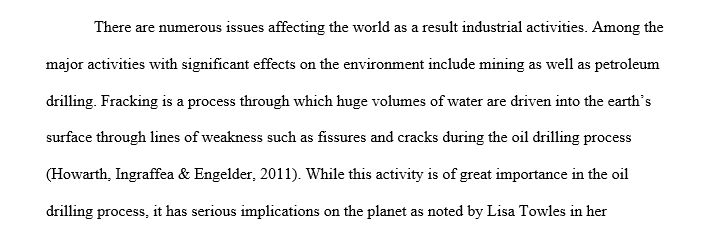Fracking and Sustainable Water Filtration Technology
Fracking and Sustainable Water Filtration Technology
I’m Lisa Towles and I’m a Senior Manager of Operations for a global tech company. I’ve been lucky to have worked all over the business world in different roles and in different industries, and for the past 18 years I’ve worked in software engineering. I feel like this degree program (MBA in IT Management) has allowed me to sort of lift the veil and see what’s going on inside the business world and, in the context of my final project, dig deep into the oil industry.
Throughout my program, I’ve focused on Exxon Mobil and fracking (hydraulic fracturing), an extension of oil and gas drilling that adds a horizontal axis onto the vertical wellbore that goes into the ground. Though fracking brings tremendous efficiency to oil and gas exploration, it’s one of the most dangerous industrial operations ever created and it wreaks havoc on the environment and on nearby communities. My particular fracking interest is water. Fracking a single well can use up to 10 million gallons of water and up to 70% of that water typically comes from surface waters (rivers, lakes, and streams), and those limited natural resources are permanently depleted (Carroll, 2015). My project within Exxon Mobil proposes a sustainable water filtration technology to purify post-consumer gray water (drained from sinks, washers, and bathtubs) using nothing but earthworms for use in fracking, in lieu of draining our natural surface waters. It’s a zero-waste, super energy efficient, renewable, and sustainable technology, and it would not only save our water supply but allow Exxon Mobil to pioneer the first ever sustainable fracking solution across the entire energy landscape.
There are currently some vague movements in the oil industry towards sustainable solutions, but I haven’t come across anything that really moves the needle in terms of environmental stewardship or, specifically, water conservation (Amis, 2015). I’ve proposed that my idea, called SafeWater Fracking, would headline a new Sustainability Division of Exxon Mobil that not only pioneers water conservation for fracking but will ultimately be able to filter fracking “flowback”, which is the toxic soup that comes up from the ground after a fracking cycle is complete.
The Exxon Mobil business leaders running SafeWater Fracking within their new Sustainability Division would be the intrapreneurs driving this new process, using creative strategies to ensure its profitability, and ultimately influencing other oil and gas competitors to create similar internal processes. Or in an entrepreneurial model, I would take on the role of the business leader securing funding to develop the new industry process on my own and with my own resources.
What was most intriguing about this week’s video (Harvard Business Review, 2012) was the idea of pursuing other markets outside of your typical customers. SafeWater Fracking would use this idea to create meaningful change by attracting a different market than the typical oil and gas consumer, as it’s a renewable, green technology. This would have market advantages because it would potentially build new revenue streams with these new environmentally-conscious consumers while still nurturing the company’s existing customer base by making fracking more efficient and its resulting products more affordable. And the projected cost-savings would please Exxon Mobil’s shareholders through improved margins.
Ultimately, my goal is for Exxon Mobil to “teach” other oil and gas companies how to create and run the SafeWater Fracking water filtration technology so that it becomes an industry standard and, 5-10 years from now, no one will be draining our natural surface waters for oil and gas exploration any longer and that will set the stage for other needed sustainability improvements.
References:
Amis, Mohomad (2015). Issues Impacting Sustainability in the Oil and Gas Industry. Retrieved from www.researchgate.net
Caroll, R. (2015). California Used 70 Million Gallons of Water. Retrieved from www.reuters.com
Harvard Business Review (2012). Disruptive Innovation Explained (Video). Retrieved from
Solution preview for the order on Fracking and Sustainable Water Filtration Technology
APA
352 words
